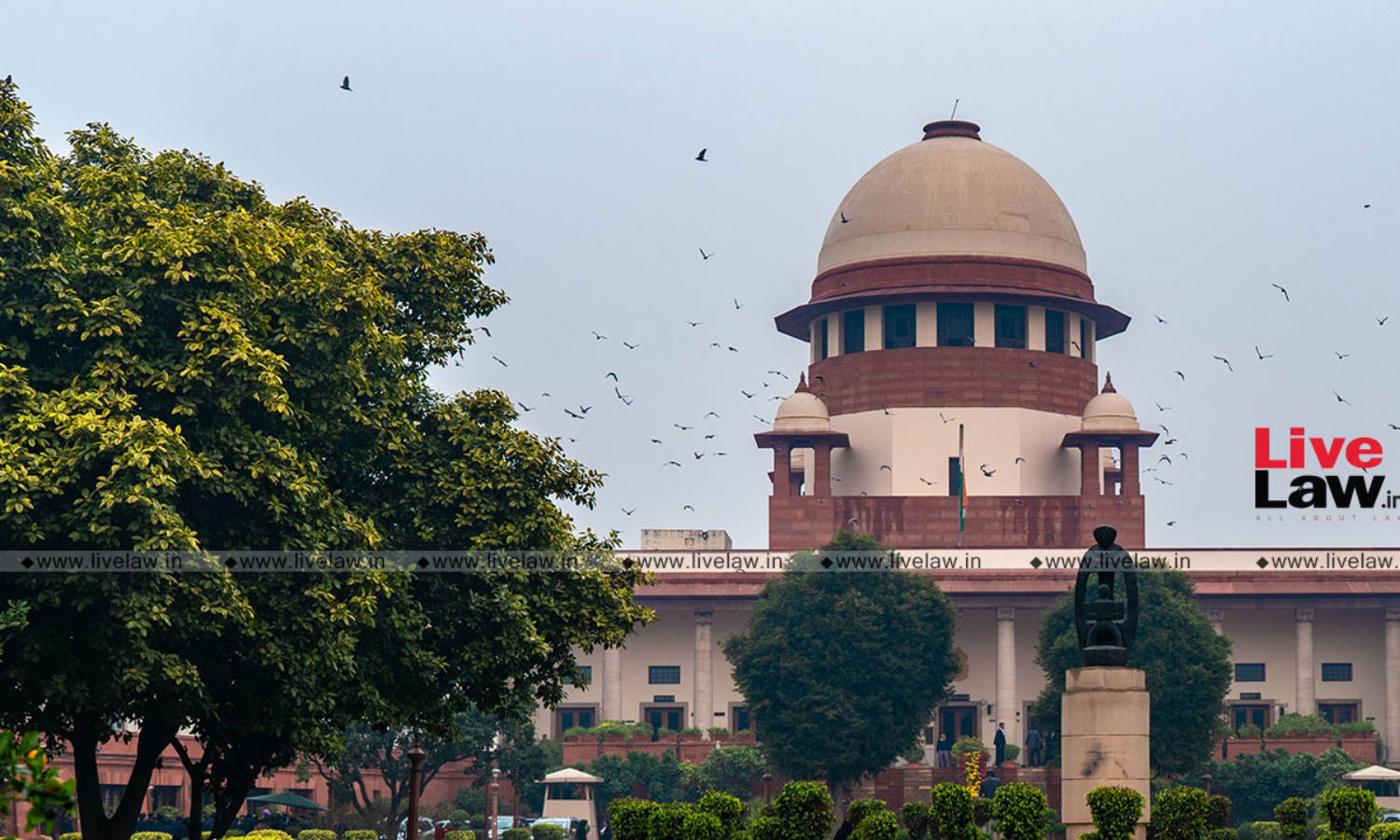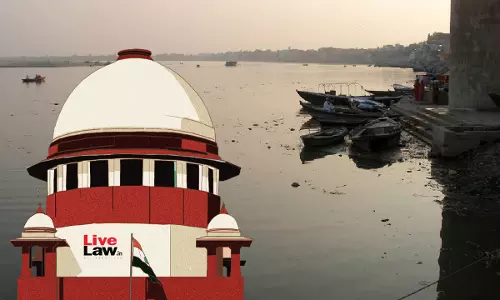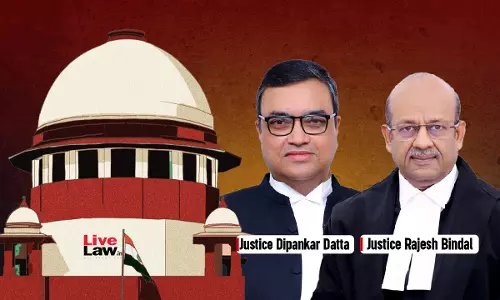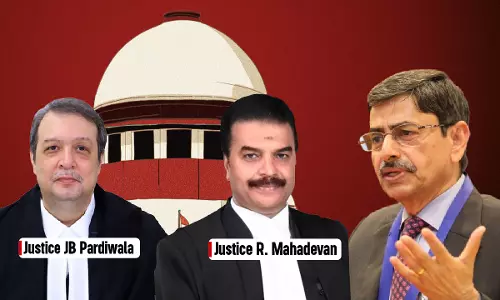Section 27 Evidence Act- Discovery Of Weapon At The Instance Of Accused By Itself Does Not Prove That He Had Concealed Or Used It : Supreme Court

The Supreme Court observed that merely because discovery of weapon was at the instance of accused, it does not mean he had concealed or used it.The bench observed thus while considering an appeal filed by a murder convict, whose conviction under Section 302 IPC was upheld by the Bombay High Court. One of the contentions raised by the appellant was that the eye witnesses in this case...
The Supreme Court observed that merely because discovery of weapon was at the instance of accused, it does not mean he had concealed or used it.
The bench observed thus while considering an appeal filed by a murder convict, whose conviction under Section 302 IPC was upheld by the Bombay High Court. One of the contentions raised by the appellant was that the eye witnesses in this case are unreliable witnesses.
In appeal, the Apex court bench held that both the courts rightly believed the two eye witnesses. However, it noticed a serious infirmity in the reasonings assigned by the trial court as affirmed by the High Court so far as the position of law as regards the discovery of weapon of offence under Section 27 of the Act is concerned.
The bench therefore proceeded to explain the correct position of law and how to appreciate the evidence of discovery in accordance with the provisions of the Section 27 of the Act.
The court noted that conditions necessary for the applicability of Section 27 of the Act are broadly as under:
(1) Discovery of fact in consequence of an information received from accused; (2) Discovery of such fact to be deposed to; (3) The accused must be in police custody when he gave informations and (4) So much of information as relates distinctly to the fact thereby discovered is admissible – Mohmed Inayatullah vs The State of Maharashtra: AIR (1976) SC 483: (1975) Cur LJ 668 Two conditions for application – (1) information must be such as has caused discovery of the fact; and (2) information must relate distinctly to the fact discovered -Kirshnappa vs State Of Karnataka : AIR (1983) SC 446 : (1983 )Cr LJ 846"
Further referring to facts and the judgment in Dudh Nath Pandey v. State of U. P, the bench observed:
"What emerges from the evidence of the PW-4 & PW-10 resply is that the appellant stated before the panch witnesses to the effect that "I will show you the weapon concealed adjacent the shoe shop at Parle". This statement does not suggest that the appellant indicated anything about his involvement in the concealment of the weapon. Mere discovery cannot be interpreted as sufficient to infer authorship of concealment by the person who discovered the weapon. He could have derived knowledge of the existence of that weapon at the place through some other source also. He might have even seen somebody concealing the weapon, and, therefore, it cannot be presumed or inferred that because a person discovered the weapon, he was the person who had concealed it, least it can be presumed that he used it. Therefore, even if discovery by the appellant is accepted, what emerges from the substantive evidence as regards the discovery of weapon is that the appellant disclosed that he would show the weapon used in the commission of offence."
A panch nama which can be used only to corroborate the panch has to be read over to the panch
The court also noted that in the examination-in-chief of the Panch does not show that he was read over the panchnama before it was exhibited. The bench, referring to Murli and another v. State of Rajasthan reported in (2009) 9 SCC 417: (2010) 1 SCC (Cri) 12 , observed:
"This Court has time and again impressed upon the necessity of reading over the panchnama which can be used as a piece of corroborative evidence. In spite of this, it is regrettable that the learned trial judge did not take the pains to see that the panchnama was read over to the panch before it was exhibited. A panch nama which can be used only to corroborate the panch has to be read over to the panch and only thereafter it can be exhibited. If the panch has omitted to state something which is found in the panchnama, then after reading over the panchnama the panch has to be asked whether that portion of the panchnama is correct or not and whatever reply he gives has to be recorded. If he replies in the affirmative, then only that portion of the panchnama can be read into evidence to corroborate the substantive evidence of the panch. If he replies in the negative, then that part of the panchnama cannot be read in evidence for want of substantive evidence on record. It is, therefore, necessary that care is taken by the public prosecutor who conducts the trial that such a procedure is followed while examining the panch at the trial. It is also necessary that the learned trial judge also sees that the panchnama is read over the panch and thereafter the panchnama is exhibited after following the procedure as indicated above.
Headnotes
Shahaja @ Shahajan Ismail Mohd. Shaikh vs State Of Maharashtra | 2022 LiveLaw (SC) 596 | CrA 739 OF 2017 | 14 July 2022
Coram: Justices Surya Kant and JB Pardiwala
Headnotes
Indian Evidence Act, 1872 - Ocular Evidence - Principles for appreciation of ocular evidence in a criminal case - In assessing the value of the evidence of the eyewitnesses, two principal considerations are whether, in the circumstances of the case, it is possible to believe their presence at the scene of occurrence or in such situations as would make it possible for them to witness the facts deposed to by them and secondly, whether there is anything inherently improbable or unreliable in their evidence. In respect of both these considerations, the circumstances either elicited from those witnesses themselves or established by other evidence tending to improbabilise their presence or to discredit the veracity of their statements, will have a bearing upon the value which a Court would attach to their evidence. (Para 27-28)
Indian Evidence Act, 1872 ; Section 27 - Conditions necessary for the applicability of Section 27 of the Act - (1) Discovery of fact in consequence of an information received from accused; (2) Discovery of such fact to be deposed to; (3) The accused must be in police custody when he gave informations and (4) So much of information as relates distinctly to the fact thereby discovered is admissible - Two conditions for application – (1) information must be such as has caused discovery of the fact; and (2) information must relate distinctly to the fact discovered. - Referred to Mohmed Inayatullah vs The State of Maharashtra: AIR (1976) SC 483 and Kirshnappa vs State Of Karnataka : AIR (1983) SC 446. (Para 42)
Indian Evidence Act, 1872 ; Section 27 - Mere discovery cannot be interpreted as sufficient to infer authorship of concealment by the person who discovered the weapon. He could have derived knowledge of the existence of that weapon at the place through some other source also. He could have derived knowledge of the existence of that weapon at the place through some other source also. He might have even seen somebody concealing the weapon, and, therefore, it cannot be presumed or inferred that because a person discovered the weapon, he was the person who had concealed it, least it can be presumed that he used it. - Referred to Dudh Nath Pandey v. State of U. P., AIR (1981) SC 911 (Para 45-46)
Indian Evidence Act, 1872 ; Section 27 - Panchnama has to be read over to the panch before it is exhibited - Panchnama can be used only to corroborate the evidence of the panch and not as a substantive piece of evidence - A panch nama which can be used only to corroborate the panch has to be read over to the panch and only thereafter it can be exhibited. If the panch has omitted to state something which is found in the panchnama, then after reading over the panchnama the panch has to be asked whether that portion of the panchnama is correct or not and whatever reply he gives has to be recorded. If he replies in the affirmative, then only that portion of the panchnama can be read into evidence to corroborate the substantive evidence of the panch. If he replies in the negative, then that part of the panchnama cannot be read in evidence for want of substantive evidence on record - Referred to Murli and another v. State of Rajasthan reported in (2009) 9 SCC 417: (2010) 1 SCC (Cri) 12. (Para 40)
Indian Evidence Act, 1872 ; Section 8,27 - Even while discarding the evidence in the form of discovery panchnama the conduct would be relevant under Section 8 of the Act. The evidence of discovery would be admissible as conduct under Section 8 of the Act quite apart from the admissibility of the disclosure statement under Section 27. (Para 48)
Indian Evidence Act, 1872 ; Section 8 - The conduct of the accused alone, though may be relevant under Section 8 of the Act, cannot form the basis of conviction. (Para 50)
Constitution of India, 1950 ; Article 136 - Criminal Appeals - (i) The powers of this Court under Article 136 of the Constitution are very wide but in criminal appeals this Court does not interfere with the concurrent findings of fact save in exceptional circumstances. (ii) It is open to this Court to interfere with the findings of fact recorded by the High Court if the High Court has acted perversely or otherwise improperly. (iii) It is open to this Court to invoke the power under Article 136 only in very exceptional circumstances as and when a question of law of general public importance arises or a decision shocks the conscience of the Court. (iv) When the evidence adduced by the prosecution falls short of the test of reliability and acceptability and as such it is highly unsafe to act upon it. (v) Where the appreciation of evidence and finding is vitiated by any error of law of procedure or found contrary to the principles of natural justice, errors of record and misreading of the evidence, or where the conclusions of the High Court are manifestly perverse and unsupportable from the evidence on record. (Para 23)
Click here to Read/Download Judgment




